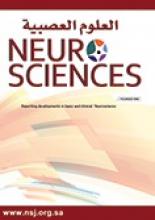Research ArticleOriginal Article
Open Access
Sensorimotor integration training in Parkinson’s disease
Ayla Fil-Balkan, Yeliz Salcı, Hilal Keklicek, Kadriye Armutlu, Songül Aksoy, Hülya Kayıhan and Bülent Elibol
Neurosciences Journal July 2018, 23 (3) 208-215; DOI: https://doi.org/10.17712/nsj.2018.3.20180021
Ayla Fil-Balkan
From the Department of Physiotherapy and Rehabilitation (Fil-Balkan, Salcı, Keklicek, Armutlu), Department of Audiology (Aksoy), Department of Occupational Therapy (Kayıhan), and from the Department of Neurology (Elibol), Faculty of Health Sciences, Hacettepe University, Ankara, Turkey
PT, PhDYeliz Salcı
From the Department of Physiotherapy and Rehabilitation (Fil-Balkan, Salcı, Keklicek, Armutlu), Department of Audiology (Aksoy), Department of Occupational Therapy (Kayıhan), and from the Department of Neurology (Elibol), Faculty of Health Sciences, Hacettepe University, Ankara, Turkey
PT, PhDHilal Keklicek
From the Department of Physiotherapy and Rehabilitation (Fil-Balkan, Salcı, Keklicek, Armutlu), Department of Audiology (Aksoy), Department of Occupational Therapy (Kayıhan), and from the Department of Neurology (Elibol), Faculty of Health Sciences, Hacettepe University, Ankara, Turkey
PT, PhDKadriye Armutlu
From the Department of Physiotherapy and Rehabilitation (Fil-Balkan, Salcı, Keklicek, Armutlu), Department of Audiology (Aksoy), Department of Occupational Therapy (Kayıhan), and from the Department of Neurology (Elibol), Faculty of Health Sciences, Hacettepe University, Ankara, Turkey
PT, PhDSongül Aksoy
From the Department of Physiotherapy and Rehabilitation (Fil-Balkan, Salcı, Keklicek, Armutlu), Department of Audiology (Aksoy), Department of Occupational Therapy (Kayıhan), and from the Department of Neurology (Elibol), Faculty of Health Sciences, Hacettepe University, Ankara, Turkey
AuD, PhDHülya Kayıhan
From the Department of Physiotherapy and Rehabilitation (Fil-Balkan, Salcı, Keklicek, Armutlu), Department of Audiology (Aksoy), Department of Occupational Therapy (Kayıhan), and from the Department of Neurology (Elibol), Faculty of Health Sciences, Hacettepe University, Ankara, Turkey
OT, PhDBülent Elibol
From the Department of Physiotherapy and Rehabilitation (Fil-Balkan, Salcı, Keklicek, Armutlu), Department of Audiology (Aksoy), Department of Occupational Therapy (Kayıhan), and from the Department of Neurology (Elibol), Faculty of Health Sciences, Hacettepe University, Ankara, Turkey
MD
References
- ↵
- Falaki A,
- Huang X,
- Lewis MM,
- Latash ML
- ↵
- Grimbergen YA,
- Langston JW,
- Roos RA,
- Bloem BR
- ↵
- Picelli A,
- Melotti C,
- Origano F,
- Neri R,
- Verze E,
- Gandolfi M,
- et al.
- ↵
- Klamroth S,
- Steib S,
- Devan S,
- Pfeifer K
- ↵
- Kim SD,
- Allen NE,
- Canning CG,
- Fung VS
- ↵
- Tomlinson CL,
- Patel S,
- Meek C,
- Herd CP,
- Clarke CE,
- Stowe R,
- et al.
- ↵
- Levitt S
- ↵
- Lane SJ,
- Schaaf RC
- ↵
- Watling R,
- Hauer S
- ↵
- Fil A,
- Armutlu K,
- Salcı Y,
- Aksoy S,
- Kayıhan H,
- Elibol B
- ↵
- Brown LA,
- de Bruin N,
- Doan JB,
- Suchowersky O,
- Hu B
- ↵
- Wulf G,
- Landers M,
- Lewthwaite R,
- Tollner T
- ↵
- Goetz CG,
- Fahn S,
- Martinez-Martin P,
- Poewe W,
- Sampaio C,
- Stebbins GT,
- et al.
- ↵
- Shumway-Cook A,
- Brauer S,
- Woollacott M
- ↵
- Duncan PW,
- Weiner DK,
- Chandler J,
- Studenski S
- ↵
- Berg KO,
- Maki BE,
- Williams JI,
- Holliday PJ,
- Wood-Dauphinee SL
- ↵
- Faraldo-Garcia A,
- Santos-Perez S,
- Crujeiras R,
- Soto-Varela A
- ↵
- Cattaneo D,
- Jonsdottir J,
- Zocchi M,
- Regola A
- ↵
- Vaugoyeau M,
- Azulay JP
- ↵
- Cohen J
- ↵
- Marchese R,
- Diverio M,
- Zucchi F,
- Lentino C,
- Abbruzzese G
- ↵
- Smania N,
- Corato E,
- Tinazzi M,
- Stanzani C,
- Fiaschi A,
- Girardi P,
- et al.
- ↵
- Gantchev N,
- Viallet F,
- Aurenty R,
- Massion J
- Tamir R,
- Dickstein R,
- Huberman M
- ↵
- Goodwin VA,
- Richards SH,
- Henley W,
- Ewings P,
- Taylor AH,
- Campbell JL
- ↵
- Rossi M,
- Soto A,
- Santos S,
- Sesar A,
- Labella T
- ↵
- Bogaerts A,
- Verschueren S,
- Delecluse C,
- Claessens AL,
- Boonen S
- Yen CY,
- Lin KH,
- Hu MH,
- Wu RM,
- Lu TW,
- Lin CH
- ↵
- Nocera J,
- Horvat M,
- Ray CT
- ↵
- Ioffe ME,
- Chernikova LA,
- Ustinova KI
- Goldberg JM,
- Cullen KE
- ↵
- Morningstar MW,
- Pettibon BR,
- Schlappi H,
- Schlappi M,
- Ireland TV
- ↵
- Therrien AS,
- Bastian AJ
- ↵
- Khan S,
- Chang R
- ↵
- Sehm B,
- Taubert M,
- Conde V,
- Weise D,
- Classen J,
- Dukart J,
- et al.
- ↵
- Klauera KJ,
- Willmesa K,
- Phyeb GD
In this issue
Sensorimotor integration training in Parkinson’s disease
Ayla Fil-Balkan, Yeliz Salcı, Hilal Keklicek, Kadriye Armutlu, Songül Aksoy, Hülya Kayıhan, Bülent Elibol
Neurosciences Journal Jul 2018, 23 (3) 208-215; DOI: 10.17712/nsj.2018.3.20180021
Jump to section
Related Articles
- No related articles found.
Cited By...
- No citing articles found.





